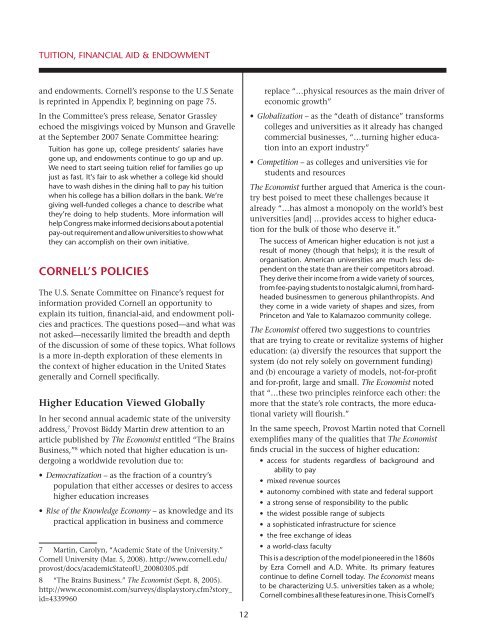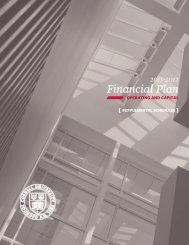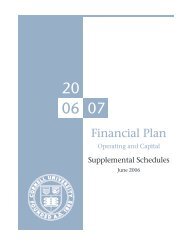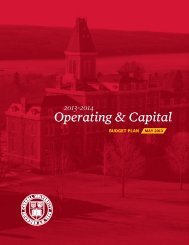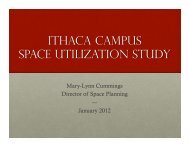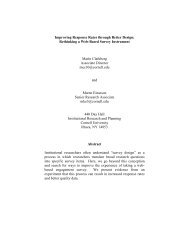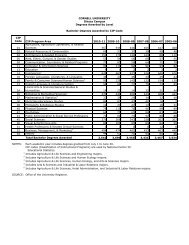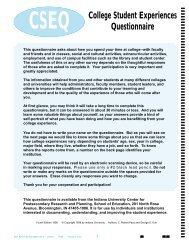Financial Plan - Cornell University Division of Budget & Planning
Financial Plan - Cornell University Division of Budget & Planning
Financial Plan - Cornell University Division of Budget & Planning
You also want an ePaper? Increase the reach of your titles
YUMPU automatically turns print PDFs into web optimized ePapers that Google loves.
Tuition, <strong>Financial</strong> Aid & Endowmentand endowments. <strong>Cornell</strong>’s response to the U.S Senateis reprinted in Appendix P, beginning on page 75.In the Committee’s press release, Senator Grassleyechoed the misgivings voiced by Munson and Gravelleat the September 2007 Senate Committee hearing:Tuition has gone up, college presidents’ salaries havegone up, and endowments continue to go up and up.We need to start seeing tuition relief for families go upjust as fast. It’s fair to ask whether a college kid shouldhave to wash dishes in the dining hall to pay his tuitionwhen his college has a billion dollars in the bank. We’regiving well-funded colleges a chance to describe whatthey’re doing to help students. More information willhelp Congress make informed decisions about a potentialpay-out requirement and allow universities to show whatthey can accomplish on their own initiative.<strong>Cornell</strong>’s PoliciesThe U.S. Senate Committee on Finance’s request forinformation provided <strong>Cornell</strong> an opportunity toexplain its tuition, financial-aid, and endowment policiesand practices. The questions posed—and what wasnot asked—necessarily limited the breadth and depth<strong>of</strong> the discussion <strong>of</strong> some <strong>of</strong> these topics. What followsis a more in-depth exploration <strong>of</strong> these elements inthe context <strong>of</strong> higher education in the United Statesgenerally and <strong>Cornell</strong> specifically.Higher Education Viewed GloballyIn her second annual academic state <strong>of</strong> the universityaddress, 7 Provost Biddy Martin drew attention to anarticle published by The Economist entitled “The BrainsBusiness,” 8 which noted that higher education is undergoinga worldwide revolution due to:• Democratization – as the fraction <strong>of</strong> a country’spopulation that either accesses or desires to accesshigher education increases• Rise <strong>of</strong> the Knowledge Economy – as knowledge and itspractical application in business and commerce7 Martin, Carolyn, “Academic State <strong>of</strong> the <strong>University</strong>.”<strong>Cornell</strong> <strong>University</strong> (Mar. 5, 2008). http://www.cornell.edu/provost/docs/academicState<strong>of</strong>U_20080305.pdf8 “The Brains Business.” The Economist (Sept. 8, 2005).http://www.economist.com/surveys/displaystory.cfm?story_id=4339960replace “…physical resources as the main driver <strong>of</strong>economic growth”• Globalization – as the “death <strong>of</strong> distance” transformscolleges and universities as it already has changedcommercial businesses, “…turning higher educationinto an export industry”• Competition – as colleges and universities vie forstudents and resourcesThe Economist further argued that America is the countrybest poised to meet these challenges because italready “…has almost a monopoly on the world’s bestuniversities [and] …provides access to higher educationfor the bulk <strong>of</strong> those who deserve it.”The success <strong>of</strong> American higher education is not just aresult <strong>of</strong> money (though that helps); it is the result <strong>of</strong>organisation. American universities are much less dependenton the state than are their competitors abroad.They derive their income from a wide variety <strong>of</strong> sources,from fee-paying students to nostalgic alumni, from hardheadedbusinessmen to generous philanthropists. Andthey come in a wide variety <strong>of</strong> shapes and sizes, fromPrinceton and Yale to Kalamazoo community college.The Economist <strong>of</strong>fered two suggestions to countriesthat are trying to create or revitalize systems <strong>of</strong> highereducation: (a) diversify the resources that support thesystem (do not rely solely on government funding)and (b) encourage a variety <strong>of</strong> models, not-for-pr<strong>of</strong>itand for-pr<strong>of</strong>it, large and small. The Economist notedthat “…these two principles reinforce each other: themore that the state’s role contracts, the more educationalvariety will flourish.”In the same speech, Provost Martin noted that <strong>Cornell</strong>exemplifies many <strong>of</strong> the qualities that The Economistfinds crucial in the success <strong>of</strong> higher education:• access for students regardless <strong>of</strong> background andability to pay• mixed revenue sources• autonomy combined with state and federal support• a strong sense <strong>of</strong> responsibility to the public• the widest possible range <strong>of</strong> subjects• a sophisticated infrastructure for science• the free exchange <strong>of</strong> ideas• a world-class facultyThis is a description <strong>of</strong> the model pioneered in the 1860sby Ezra <strong>Cornell</strong> and A.D. White. Its primary featurescontinue to define <strong>Cornell</strong> today. The Economist meansto be characterizing U.S. universities taken as a whole;<strong>Cornell</strong> combines all these features in one. This is <strong>Cornell</strong>’s12


